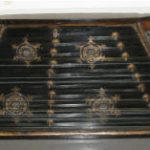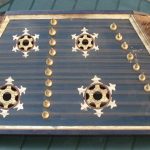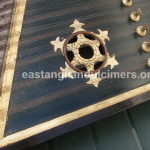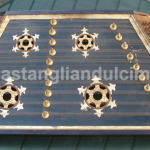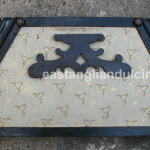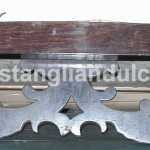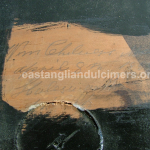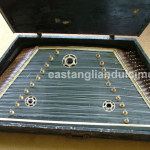Dulcimers made by William Chilvers (1809-1878)
Three dulcimers are believed to have been made by William Chilvers, one is definite, two likely, but possibly made in partnership with a carpenter.
Chilvers No.1
The first one we came across was played by several generations of the same family – James Philpot (1841-1911, who had lived in the same street in Halesworth as William Chilvers), Charlie Philpot (1877-1965), Reg Reader (1937-2014). It now belongs to the fourth generation of the family to play the dulcimer, Reg’s grandson Tom Knights.
It has four soundholes and five strings per course over 20 bridges.
The Philpot family had lived in Chediston Street from the mid 1880s and bought their dulcimer from a Mr Howard and they understood that he had made it. According to family memories, Mr Howard was a picture framer, so it seemed likely that he might have put the finishing gilt decorations on the dulcimers, having that specialist skill.
My research has turned up two possible contenders for this Mr Howard, who also claimed to have been a world champion” dulcimer player” by beating a clown at a circus! This has been a clue that has led me to identify him as most likely to have been John Thomas Haward, a painter, decorator, paper-hanger and glazier by trade. Have a look at his page for the circus story where you’ll also find out the role of a pair of boots in the tale of this dulcimer!
The other story in the Philpot family was that the maker had only ever made two dulcimers like this.
Imagine our astonishment then, when we found its identical twin in the early 21st century!
Chilvers No. 2
John Howson saw a dulcimer advertised for sale in Hingham, Norfolk. He was excited, hoping it was perhaps linked to the legendary Billy Cooper, who had lived there until his death in 1964. John bought the dulcimer and came back feeling rather bemused. It looked strangely familiar. Then the penny dropped – it was a doppelganger for the instrument we had been sitting next to for the previous 25 years, played by Reg Reader! How amazing that they had both survived for 150 years in superb condition.
I believe we did have a positive ID on this instrument being made by William Chilvers but I can no longer find what it was that led us to be certain about this, so at present I am saying we believe it to be by William Chilvers, but it is very definitely by the same maker as No. 1 on this page. Perhaps John found proof, but he didn’t document what that was and I no longer remember!
The design of this instrument is identical in every respect to No. 1 and has four soundholes and five strings per course over 20 bridges.
Chilvers No. 3
The third is in also in private hands and has the inscription ‘William Chilvers, April 8th 1859, Halesworth Suffolk’ inside the instrument. It’s possible that it also says ‘maker’ after Chilvers’ name, but that is partly masked by some black paint applied during a poor renovation job. In 2009, when the present owner removed the unsatisfactory replacement soundboard, the signature was discovered, so at least the previous ‘restorer’ did us this favour! The instrument had been found as part of a house clearance in the Sandringham area in north east Norfolk.
Return to the home page for William Chilvers
All material on this website is copyright. Anyone wishing to quote or use this original research should credit it to Katie Howson and cite this website as the source. Please see our Terms and Conditions page for more information, and do contact me if you wish to use any of the contents in any way. Thank you.

